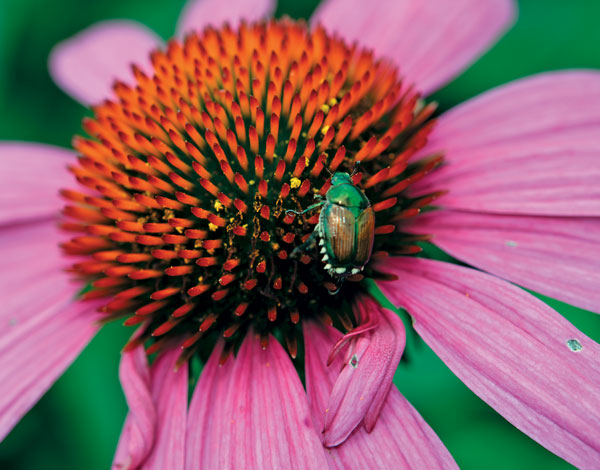2/1/2020
Newer Chemical Class Bolsters Insecticide Rotations
Rick Yates

Diamide insecticides (MOA 28) have been around for several years, with the first greenhouse registered product being Syngenta’s breakthrough product Mainspring, now called Mainspring GNL, registered in 2016. In the past year, Syngenta expanded the label for Acelepryn to include nursery and greenhouse uses, while OHP introduced two new insecticides, Pradia and Sarisa. Many growers searching for replacements for rotations with neo-nicotinoids have incorporated diamide insecticides into their programs.
Pictured: Initially a turf and landscape product, Acelepryn benefits nursery crops as a foliar spray to control Japanese beetle adults and other insect pests.
While each product has unique attributes, there are some important things they have in common. Plant and bloom safety are a strong suit for this class of chemistry. Mainspring GNL has been used widely by greenhouse and nursery growers on a large number of ornamentals over the past few years, yet GGSPro’s technical team hasn’t received a single report of phytotoxicity to date.
Diamide insecticides are broad spectrum with an impressive array of important insect pests on their labels. Add to that good compatibility for tank mixing ability.
Bee safety is an important criterion when evaluating pesticides. In general, bee toxicity for this group of insecticides is short-lived, allowing growers to treat blooming crops safely when all label requirements are followed.
Acelepryn has no bee cautions on the label. More data is needed on the newer products, but compatibility with BCAs is promising. Add short re-entry intervals (REIs) into the equation and it’s easy to see why the diamides are generating so much interest.
• Acelepryn—Initially a turf and landscape product, the expanded label gives nursery and greenhouse growers an option for long-lasting caterpillar control from a spray or drench. Nursery crops benefit from Acelepryn foliar sprays to control lacebugs, Japanese beetle adults and wooly adelgids. Bark applications and soil drenches add long-term control of aphids, birch leafminer and white grub control, among other pests.
• Mainspring GNL—Over the past few years, growers have reported that foliar sprays have provided two weeks or more of control of a wide variety of beetles and caterpillars, as well as lacebugs and thrips. Acropetal movement into new foliage extends the length of control from sprays and drenches. Drenches of Mainspring GNL are particularly effective with a residual of six to eight weeks or longer. In addition to the pests controlled by sprays, drenches add control of aphids, leafminers and whiteflies.
• Pradia—The diamides released to date haven’t shown good control of aphids from foliar sprays. OHP addresses this with the addition of flonicamid as a second active ingredient. Flonicamid not only adds aphid control, but enhances activity against mealybugs, thrips and whiteflies. You might recognize flonicamid as the active ingredient in Aria. In addition to the previously mentioned insects, the label includes beetles, caterpillars, lacebugs and leafminers.
• Sarisa—This product may find its niche in the nursery. Some early grower reports indicate a good knockdown of the troublesome red-headed flea beetle. We expect this recently released product to have good activity against several nursery pests, including beetles, caterpillars, lacebugs, leafminers and plant bugs.
 Since these products share the same MOA, growers will need to rotate outside of this group in accordance with their labels and sound rotational strategies.
Since these products share the same MOA, growers will need to rotate outside of this group in accordance with their labels and sound rotational strategies.
Griffin GGSPro is available to advise you on pesticide programs. Excerpts from the labels have been included, but it’s the grower’s responsibility to read and follow all label requirements. These products aren’t registered in all states and counties. Consult Griffin GGSPro or your state department of agriculture for up-to-date registration information. GT
Rick Yates is GGSPro Technical Support Manager for Griffin. He can be reached at ggsprotech@griffinmail.com.